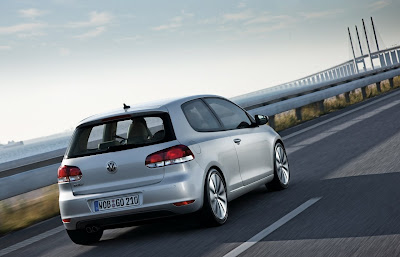
.
According to Autocar Volkswagen is preparing three hot versions of the new Golf. The first one to arrive will be the reincarnation of the famous Golf GTD. This version, scheduled for the spring of 2009, will feature a 2.0 litre TDI engine with an expected 200 hp and tons of torque. The current R32 will be replaced by a GTI Plus version with the 2.0 litre TSI engine delivering around 270 hp. A seven-speed flappy paddle gearbox and a non-permanent four-wheel drive system will command the car's huge power. Finally, the R version, possibly a R42, will feature a 2.5 litre turbo-charged five-cylinder engine developing about 350 hp. This last version should arrive on the market in 2010.
.
Next is the original Autocar article.
.
"VW plans three hot Golfs
.
Autocar has learned that Volkswagen is planning to launch three all-new performance VW Golf variants within the next three years.
.
A performance diesel Golf – dubbed the GTD - is scheduled for launch in the spring of 2009. It will use the VW Group’s latest twin-turbocharged 2.0-litre TDI engine, offering in excess of 200bhp and 260lb ft torque.
.
VW bosses have wanted to deliver a diesel-engined GTI since the Mark 5 went on sale in 2003. The combination of stringent European CO2 laws, the current economic climate and the arrival of the latest twin-turbo TDI technology means that the VW Golf GTD is now a certainty.
.
VW is also looking at a Golf GTI ‘plus’ model. This harder-core version of the GTI will use a tuned version of the standard car’s 2.0-litre TSI engine to deliver up to 270bhp. It will also have a seven-speed DSG gearbox and a Haldex clutch providing non-permanent four-wheel-drive. This GTI ‘plus’ will replace the current-generation R32, although it also looks set to come close to entering the territory already occupied by sister company Audi’s S3.
.
The final new performance Golf is likely to be another ‘R’ variant, possibly the ‘R42’, which is pencilled in for a 2010 launch. This will use a 2.5-litre turbocharged five-cylinder engine that will be shared with the forthcoming Audi TT RS, giving the Golf around 350bhp along with competitive fuel economy and CO2 figures.
.
According to Volkswagen insiders the spate of new high performance Golfs has been brought about by an influx of Audi engineers into Volkswagen, and a move to bring about more component sharing between the two companies."
.
Source: Autocar.
.













































































